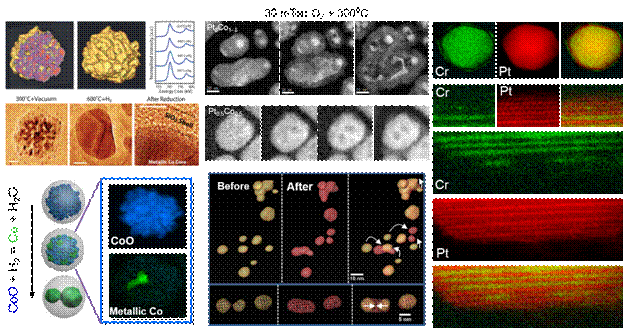题目:Atomic-Resolution Spectroscopic Imaging and In Situ Environmental Study of Bimetallic Nanocatalyts
时间:2013年9月26日上午10:00
地点:硅材料国家重点实验室1号楼102室
Bimetallic nanoparticles are promising candidates for electro- and heterogeneous catalysis because their catalytic activity isfrequently superior to their monometallic counterparts. However, theadditional degree of freedomintroduces a new complexity into the mechanism because the distribution of the two metals may vary during reaction. For example, preferential adsorption of reactive molecules can induce segregation of one component, structural changes, and element-specific phase transformations. Uncovering the chemistry, structure, and degradation pathways of materials under catalytic conditions is of fundamental importance forestablishing structure-property relationships and forthe design of new catalytic materials.
Aberration-corrected scanning transmission electron microscopy (STEM), in combination with electron energy loss spectroscopy (EELS),is exquisitely poised for studyingstructural, compositional, and electronic properties of nanocatalysts. The enlarged numerical aperture coupled with the use of a cold-field-emission gunallows for the acquisition of 2-D compositional and bonding maps of both bulk and nanostructured materials at atomic resolution. Additionally,the development and inclusion of differentially-pumped gas cells inside a transmission electron microscope (TEM) permits the visualization of solid-gas chemical reactions in situ.Imaging atomic-scale reaction dynamics and the acquisition of spectroscopic fingerprints allows us to reveal reaction pathways that cannot be resolved by any other approach.Here, I will provide background on our techniques,including STEM, EELS, electron tomography, and in situ environmental methods, and I will show how the surface and internal structures ofPt-transition metal bimetallicnanocatalystsreconstruct in response to annealing, acid leaching, operational aging, gas oxidation, and reduction. I will also discuss the current challenges and future prospectsforquantitativeenvironmental TEM.

个人简介:
忻获麟2005年本科毕业于北京大学物理学院物理学专业,随赴美留学康奈尔大学物理系,师从大卫.A.穆勒(David A. Muller)教授学习电镜显微学和电子能量损失谱学。2011年8月获得物理学博士学位,随后在劳伦斯伯克利国家实验室从事博士后工作,现已获得布鲁克海文国家实验室的研究员PI职位。忻获麟在博士学习期间,从事原子级扫描投射电镜以及能谱相关的理论和技术研发,在原子级空间分辨非弹性散射定量理论,高能电子隧道理论,以及三维重建理论方面均有创新和建树。除了理论和方法论的研究,他应用原子级谱学方法和三维断层扫描技术对生物矿化物,二元金属催化剂以及复杂氧化物界面等多方面进行了深入的研究。在博士期间,由于他的创新工作,他多次获得来自美国显微学会和美国微束学会办法的奖项,包括卡斯特因奖两次,杰出学者奖一次。他博士期间工作共发表刊物文章22篇,一作(包括共同一作和通讯)12篇。其中以一作(包括共同一作)在Science, Nature Materials,Nature Nanotechnology以及Nano Lett.上发表工作。发表的文章多次被国际知名科技媒体报道,包括C&E news, physicsworld.com, Materials360, Nature Chemistry, Nature Nanotech, ScienceDaily.com, Department of Energy Press Release等。自2011年8月起,他投入环境透射电镜的博士后研究,至今一作(包括共同一作和通讯)发表文章10篇。他同期利用世界上唯三的电子色差矫正仪发明了共焦电子能量损失谱学,因此他于2012年8月份获得了美国显微学会颁发的总统博士后奖。他在博士以及博士后期间的工作受到电镜显微学同仁的广泛认可,先后10余次受大会和研讨会邀请演讲。



